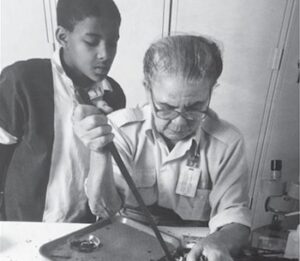
Margaret Collins
*Margaret Collins was born on this date in 1922. She was a Black entomologist (zoologist) and a civil rights advocate.
Margaret James was born in Institute, West Virginia. Collins was the fourth child of Rollins James and Luella Bolling James. The institute was an all-Black town and a college town. Collins's father earned his bachelor's degree from West Virginia State University and his master's from Tuskegee Institute. He worked with George Washington Carver for a while. Taught Vocational Agriculture at West Virginia State, ran the poultry program at West Virginia State, taught at West Virginia State's laboratory high school, and was a county agent for the USDA. Collins's mother, Luella James, wanted to become an archaeologist. Still, her studies at West Virginia State were limited because of her gender, and she later dropped out of college.
From an early age, young James was fascinated by zoology. Inspired by naturalist Ernest Thompson Seton's books Two Little Savages and Rolf in the Woods, she would explore the woods and barn near her childhood home to collect insects. When James was just 6 years old, she was recognized as a child prodigy and was given access to the book collections at West Virginia State University's Library. James's impressive intellect and university-level reading skills allowed her to skip two grades and graduate at 14 from West Virginia State University's Laboratory High School.
In 1936, she started her first year on an academic scholarship at West Virginia State University, a historically Black university. She faced many difficulties as an undergraduate there due to her gender. She struggled to find a mentor in Biology and eventually received mentorship from Toye Davis and Frederick Lehner. They helped find James opportunities in the field of Biology. In 1943, Collins gained her Bachelor of Science in Biology with minors in Physics and German. Later, in 1943, James enrolled in the University of Chicago, graduating in 1950 with a Ph.D. in zoology. Alfred E. Emerson, a termite expert, mentored Collins, assisted Collins in her studies, and shielded her from racism. Still, he did not let her do fieldwork yet helped James develop and complete her dissertation, Differences in Toleration of Drying among Species of Termites (Reticulitermes). Collins also wrote an article based on her dissertation in Ecology, the journal of the Ecological Society of America.
When James received her PhD., she became the third African American female zoologist and the first female entomologist. James was an assistant professor at Howard University in Washington, District of Columbia, while her first husband, Bernard Strickland, attended Howard University's Medical School. She later divorced Strickland and left Howard University because it did not treat its women and men faculty members equally. She started working for Florida A&M University and, while there, married her second husband, Herbert L. Collins. They had two sons.
Collins was appointed a full-time professor at Florida A&M, becoming chair of the biology department in 1953. She often went on collecting trips in Everglades National Park with her family. While in Florida, Collins was a guest lecturer at a local predominantly White university on biology and equality. The lecture was canceled due to a bomb threat. Collins also volunteered to drive people to work during the Florida A&M Student Council's bus boycott. Collins was watched closely by the police and the FBI because of her actions against racial inequality. Collins's advocacy for equal rights limited her scientific work from 1952 to 1957, and she did not publish any papers at this time.
Collins applied for and received a grant from the National Science Foundation to study at the University of Minnesota for a year. From 1961 to 1962, Collins was a research associate at the Minnesota Agricultural Experimental Station in St. Paul, where she studied North American termites. In 1964, she returned to Howard University as a full-time professor. Collins also took a tenured position at Federal City College for ten years. Additionally, Collins became president of the Entomological Society of Washington in Washington, D.C., and a research associate at the Smithsonian Institution.
In 1968, with grants from the Smithsonian and the Graduate School of Howard University, Collins led an expedition to Mexico. In 1972, she took a research trip to the Sonoran Desert in Arizona, which the United States IBP Desert Biome Project and the National Science Foundation supported. The same year, Collins was invited to the Clark Lectureship at Scripps College. While involved in field research in Guyana, Collins reopened the Alfred Emerson Research Station in 1979. Also, in 1979, Collins orchestrated a symposium for the American Association for the Advancement of Science. The symposium's focus was on Science and the Question of Human Equality. After the seminar, she published a book with the same title as the symposium's focus, Science and the Question of Human Equality.
In 1979, Collins started researching the defense mechanism of termites with Glenn D. Prestwich. From the late 1970s to 1996, Collins researched termites in the Caribbean through the Smithsonian's National Museum of Natural History, Department of Entomology, with a particular focus on the termites of Guyana. The Collins Collection curated the materials she collected at the National Museum of Natural History.
Collins was nicknamed the "Termite Lady" because of her extensive research on termites. Although she had health problems during the 1980s and 1990s, Collins increased her work in the field, taking various expeditions to the Caribbean. On April 27, 1996, Collins died at the age of 73 at the Southern Cross Club in Little Cayman, Cayman Islands, on an expedition due to congestive heart failure.